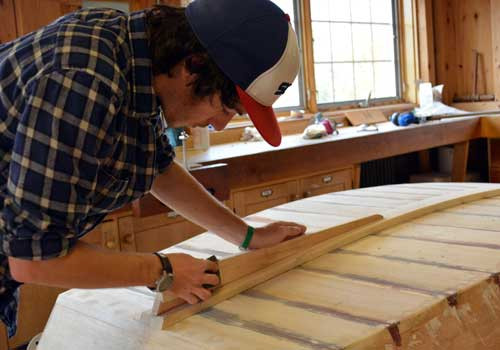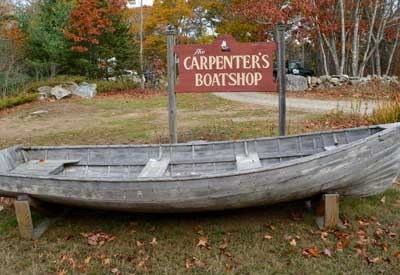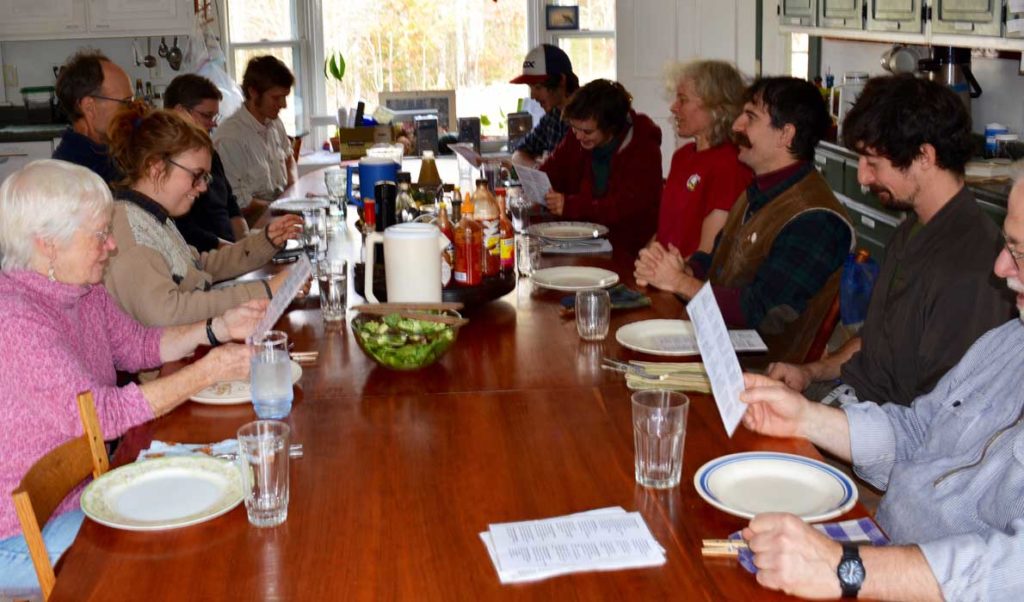By Meghan Vigeant
On a typical day at the Carpenter’s Boat Shop in Pemaquid, you might find apprentices restoring an old rowboat or sanding the hull of a Mohegan skiff. You might also find them doing things like roofing the barn, baking a mac and cheese casserole, digging beets in the garden, discussing feminist literature, splitting wood or mentoring kids at the local school.
Being an apprentice at the Carpenter’s Boat Shop isn’t just about building boats; it’s about charting a course of purpose and being part of a community.
The Carpenter’s Boat Shop was founded in 1979 with three primary functions: to serve as a boat school, an intentional community, and a “safe harbor.” Apprentices may be fresh out of school, recently divorced, or sobering up, and all are navigating the rough seas of life’s transitions.
On a crisp fall morning, I find apprentice Pippa Adam in the restoration shop gluing handmade toothpicks into little holes on the hull of a 1950s-era wooden motorboat.
Adam, 22, recently finished a degree in sculpture at Massachusetts College of Art and Design and was having what she describes as an “existential crisis.” She asked herself, “Why art? What’s the point?” She craved to make something functional and Googled “wooden boatbuilding in Maine” and found the Carpenter’s Boat Shop. She enjoys the combination of gaining new skills and doing it in the context of community.
FINDING THE PASSION
At tea break, a tall salt-and-pepper-bearded apprentice apologizes for not shaking my hand due to his sticky fingers from the honey he put in his tea. Paul Englund came to the Boat Shop from Wisconsin to find his passion.
“Our society doesn’t have many forms of ritual for coming of age. Even though I am 62 years old, I was never initiated into full adulthood and manhood,” he says. Englund believes he is achieving that by making something beautiful and useful. “I can see my own hands doing it.”
“Carpenter” is a reference to Jesus, but the Carpenter’s Boat Shop is not a proselytizing organization and doesn’t subscribe to any specific faith, but it does emphasize cultivating a deep spirituality.
Englund recognizes this.
“I’m trying to get rid of the ghosts of my religious upbringing.” The shop community has offered him acceptance and affirmation. He likes that “you are supported to be the best person that you are.”

MEGHAN VIGEANT
Tom Limongello sands a Monhegan skiff.
Kim Hoare, now director of the Carpenter’s Boat Shop, was an apprentice 20 years ago after burning out in her job as a mathematical statistician with the U.S. Census Bureau. This is where she figured out how she wanted to live her life.
“For me it’s all about helping others,” she says.
Hoare went on to attend Yale Divinity School, become a United Church of Christ minister and work with Habitat for Humanity. As Boat Shop director, she is able to see how the program transforms the lives of apprentices.
WORKING FOR ROOM, BOARD
The apprentices work 40 hours a week and receive room and board in exchange.
“They pay nothing to be here and are paid nothing to be here,” Hoare explains.
The program is funded by the sale and restoration of the boats apprentices work on, as well as donations, grants and a small endowment. Remaining tuition-free is a key part of the mission.
Apprentices still have to pay their bills for things like car insurance and cell phones, all while dedicating nine months to the apprenticeship, but not having to pay tuition removes many of the barriers.
Following a firm schedule and learning to live with others were two of the most common challenges apprentices cited as they adjusted to life at the Boat Shop.
“We’re not monks here,” Hoare notes, but the shop works to create a life of balance based on work, prayer, study, service, worship, recreation and hospitality.
At 12:20 p.m. an apprentice goes outside the dining hall to ring the bell for lunch. Within ten minutes all apprentices and instructors are gathered family-style at a long table. The push to put work tools down and arrive on time for the next thing on the agenda may chafe for some, but the joy of coming together as a community is evident as they sing grace—or rather a goofy song with shouts of cheer, thanking the plants, animals and minerals that have made this meal possible.
After lunch and a group book talk, the apprentices head back to work on their Mohegan skiffs and other projects. As they learn how to be careful working with their hands building boats, Hoare takes comfort that “they’re becoming more caring in their own life. We know that our apprentices will come through the program and leave as more compassionate, courageous and committed individuals.”
For more information, see: carpentersboatshop.com






